Languishing is a state of emptiness and apathy. It has emerged as a significant mental health concern. This issue involves a lack of vitality and engagement in life.
So, how to get back to normal life? One key approach is finding flow. It describes a state of complete immersion and enjoyment in an activity. When you are in flow, you experience a sense of:
- Purpose
- Challenge
- Effortless action
This state of optimal experience can serve as a powerful antidote to languishing. It fosters a sense of meaning and fulfillment. Recognizing the signs of a problem and actively seeking ways to fix it are crucial. And with our guide, you will find out how to cope with it.
How to Stop Languishing and Start Finding Flow
Understanding the signs is essential for dealing with this issue. The most common signs are:
- Reduced Motivation and Energy. You may feel drained and apathetic. You lack the drive to pursue goals.
- No Interest in Activities. People lose pleasure in hobbies, interactions, and everyday tasks.
- Emotional Numbness. You may feel a sense of emptiness, apathy, and a lack of positive emotions.
- Difficulty Concentrating. People usually struggle to focus. They may experience brain fog and feel easily distracted.
- Social Withdrawal. Feeling less connected to others. People usually avoid social situations and feel a sense of loneliness.
The problem can have a significant impact on us. It can lead to decreased productivity, strained relationships, and a sense of dissatisfaction.
Fortunately, there are tactics to combat languishing. With them, you can cultivate a more fulfilling life. Here are some steps you can follow:
- Find Passions and Interests. Explore activities that bring you joy and ignite curiosity.
- Set Realistic Goals. Break down large goals into smaller, manageable steps. It usually helps maintain momentum.
- Mindful Activities. Practice mindfulness meditation. Consider deep breathing exercises and spending time in nature.
- Focus on Physical Activity. Regular exercise can boost mood. It increases energy levels and improves mental function.
- Cultivate Meaningful Connections. Nurture relationships with loved ones. Also, engage in social activities and build a strong support network.
- Practice Gratitude. Regularly reflect on the positive aspects of your life. Appreciate the small joys and express gratitude for the good things in life.
- Embrace Challenges. Step outside your comfort zone. Try learning new skills and pursue activities that require focus and effort.
As for flow, it describes a state of complete immersion and enjoyment. When you’re in flow, not languishing, you feel a sense of purpose and effortless action.
Key characteristics of flow include:
- Clear Goals and Feedback. You may have a well-defined objective and receive continuous feedback on progress.
- A Sense of Control. The person usually feels in command of the situation and can influence the outcome.
- Loss of Self-Consciousness. You may be so absorbed in the activity that self-awareness fades away.
- Distorted Sense of Time. Time seems to fly by. It’s because we become engrossed in the activity.
Research studying how to stop languishing found that flow experiences have many pros for mental health. They include:
- Increased Happiness. Flow promotes positive emotions and a sense of life satisfaction.
- Reduced Stress and Anxiety. Flow provides a temporary escape from worries and anxieties.
- Enhanced Creativity and Productivity. People foster innovative thinking and improve performance in many domains.
- Improved Self-Esteem. Flow helps build a sense of mastery and accomplishment.
The Difference Between Languishing and Depression
When comparing languishing vs depression, you need to understand that the two terms imply emotional distress, but they differ in severity and signs.
Depression is a serious mental condition that is characterized by:
- Persistent sadness
- Hopelessness
- A loss of interest in most or all activities
Languishing is a more subtle and pervasive state of emotional emptiness. It’s often described as feeling “meh” or “going through the motions” without experiencing any intense negative emotions.
It can be overlooked because it doesn’t involve the dramatic signs of depression, for example, suicidal thoughts, severe anxiety, or weight loss. However, it can still have a profound impact on well-being and life.
Recognizing signs can be hard, as they often manifest in subtle ways. Pay attention to changes in your daily routines, including decreased motivation, difficulty concentrating, and no interest in things usually liked.
Insights from Adam Grant on Languishing and Flow
In a TED episode, psychologist Adam Grant explores the concept of feeling apathy. He emphasizes the importance of recognizing and addressing this state. It’s particularly true in the aftermath of major life events or periods of prolonged stress.
Grant argues that flow can serve as a powerful antidote to a problem. We can engage in activities that challenge and absorb our attention. Then, we can regain a sense of purpose, meaning, and fulfillment. He encourages people to find their passions. Setting meaningful goals is important and cultivates a sense of mastery in chosen pursuits.
Key takeaways from Adam Grant’s work on languishing include:
- Recognize the Signs of a Problem. Pay attention to subtle changes in emotional state and behavior.
- Embrace Challenges and Step Outside Comfort Zone. Seek out opportunities for growth and learning.
- Cultivate a Sense of Purpose. Engage in activities that align with your values and passions.
- Build Strong Relationships. Connect with others and nurture meaningful connections.
- Focus on Self-Care. Make time for activities that bring you joy and relaxation.
Creating the Conditions for Flow in Everyday Life
Cultivating flow requires a multifaceted approach. It addresses internal and external factors:
- Mindset. A growth mindset is crucial. Embrace challenges as opportunities for learning and improvement. Focus on the process of engagement rather than solely on the outcome when stopping languishing. Cultivate a sense of curiosity and a willingness to experiment. Practice mindfulness to quiet the mind and increase focus.
- Environment. Minimize distractions. Create a dedicated workspace free from interruptions. Arrange your environment to suit the activity. Ensure adequate lighting, comfortable temperature, and access to necessary tools.
- Habits. Establish consistent routines that support flow. Set aside dedicated time for focused work or creative pursuits. Break down large tasks into smaller, more manageable steps. Regularly review and change your approach based on experiences.
How to Incorporate Flow into Your Work and Personal Life

Incorporating flow into your work and life can enhance productivity and well-being. Here are some actionable steps on how to stop languishing and start finding flow.
Work:
- Find Flow-Inducing Tasks. Determine which tasks at work consistently absorb you and challenge you in a positive way.
- Set Your Workspace. Minimize distractions. Create a dedicated workspace and ensure you have the necessary tools and resources.
- Schedule Dedicated Flow Time. Block off specific times in your calendar for deep work and reduce interruptions during these periods.
- Break Down Large Tasks. Divide complex projects into smaller, more manageable steps. It helps maintain focus and momentum.
- Seek Out Challenging Projects. Embrace new challenges and opportunities for growth.
How to Stop Languishing: Personal Life:
- Explore Passions. Identify activities that you find intrinsically rewarding and that bring you a sense of joy and fulfillment.
- Set Achievable Goals. Establish clear goals for your hobbies and personal pursuits.
- Mindfulness. Engage in activities that help you quiet your mind and increase self-awareness. For example, meditation, yoga, or spending time in nature.
- Connect with People. Engage in social activities. Volunteer your time and nurture meaningful relationships with loved ones.
- Prioritize Self-Care. Make time for activities that help you relax and recharge. For example, reading, listening to music, or spending time in nature.
Incorporating mindful intention into your daily life, especially through cultivating flow, can unlock profound personal growth. When you’re fully immersed in an activity, time seems to disappear. And you experience a deep sense of joy. This state of flow enhances creativity, boosts productivity, and fosters a deeper connection to yourself. With flow, you can cultivate a life of purpose, reduce stress, and experience greater well-being.
Why Finding Flow is Crucial to Overcoming Languishing
Feeling weakened can leave us feeling adrift and unfulfilled. But the good news is that there’s a powerful way how to stop languishing. As we said, flow is a state of complete immersion in an activity. It offers a pathway out of the state of languishing.
When we’re in flow, we experience a sense of purpose, challenge, and effortless action. Our minds become fully engaged and time seems to fly by. This deep engagement:
- Rekindles our passion.
- Ignites our creativity.
- Restores our sense of vitality.
Flow not only counteracts the apathy and disengagement that characterize languishing. It also cultivates a sense of meaning and accomplishment. By immersing ourselves in activities that challenge and absorb us, we rediscover our inner strengths. We can build confidence and cultivate a deeper sense of self-worth.So, take the first step. Find activities that spark your interest and challenge you. Experiment with different approaches. And don’t be afraid to step outside your comfort zone. Embrace the journey of finding flow, and leave the emptiness behind.






